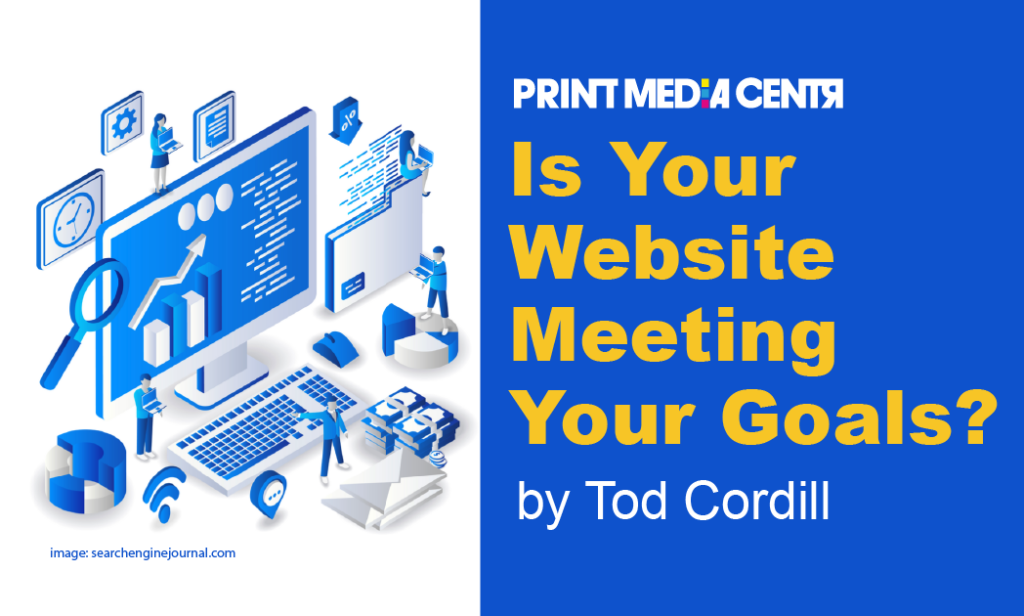
Over the past few months, I’ve written about the changes in Google search results pages and how they impact companys’ search performance. There are many ways people may learn about suppliers. Ranking high in search results may not be essential for every company. But a company’s website is important in most buying processes.
Goals for Websites
There are many ways a website can help people along their customer journey through the Awareness > Consideration > Decision process.
Awareness
People often learn that companies exist through a web search that leads them to a company website. Informational intent searches will often lead people to a blog with helpful information. These people may not be looking to buy soon, but as they land on your website, they learn that your company exists.
People with a transactional intent searches are ready to buy. Searches on terms like commercial printer, digital printer near me, or direct mail providers are examples of transactional intent searches by people prepared to make a purchase.
Inform
A websites need to answer these questions:
- Who: who you are and who you serve
- What: describes your products and/or services
- Why: what the customer benefits are
- Where: physical location(s), where you offer your services, contact information
- When: hours, seasonal offerings
Build Trust
People trust businesses more than NGOs, governments, and media. Don’t squander this. Trust is difficult to gain and easy to lose.
Your website will help you earn trust when:
- It is easy to navigate
- It is easy to find and discover useful information
- It works on mobile devices
Digital Wayfinding
A website should make it easy to find your location(s) in the real world and make it easy to find how to contact you. Give people phone numbers, email, a form to fill out, and social media links so they can contact you in a way that works for them.
Generate Leads
A website can be a significant source of leads. Ways people can find your website include:
- Organic search (SEO) (informational > blogging, transactional > product pages, contact us)
- Ads – digital or offline
- Referrals (branded search)
To become leads, people need to provide contact information. The most important pages on a website include:
- Landing pages
- Product or service page(s)
- About page
- Home page
- Contact us page
The landing page might be a lead generation page with a form, the home page, or a blog post discovered in a search.
Generate Revenue
The internet has changed customers buying process – but many companies still haven’t changed their sales processes. Don’t sell like it’s 1999. B2B and B2C company websites sell digital products, physical products, and services.
Types of Websites
Brochure Website
Not every company needs to continually invest in website content that people will find in Google searches. There are many ways people can learn of you that don’t depend on Google. Ways people can discover that your company exists include sales outreach, prospecting direct mail, online and offline advertising, and word-of-mouth referrals. If these are effective for your company, you don’t need to continually update your website.
A brochure website needs to be easy to navigate, easy to read, and have good enough SEO that you show up in branded searches. Or better yet, own the branded search page. Creating your Google Business Profile helps with this.
Make it easy for your website visitors to contact you. Include your phone number and either a contact form or an email address link. Make sure that your email address link is a mailto: hyperlink so that someone can click on it on their desktop computer or mobile phone.
Include information for all your audiences, including customers, prospects, potential employees, and people that want to sell you stuff. Maybe don’t worry about the last one. They’re going to find you anyways.
Lead Generation Website
The website can be an essential source of leads for companies with long sales cycles and complex, custom products. A lead generation website needs to address the same information as a brochure website, but not necessarily in the same detail, because:
- You plan to follow up once a lead’s contact information is received
- Omitting details can generate questions
A lead generation website should include a phone number but use a contact form instead of an email address. Using a contact form allows:
- Pushing form fill information into CRM as a lead and create a task or new opportunity.
- With marketing automation, the website visitor becomes a known visitor instead of an anonymous visitor.
- Send an automated notification email that lets the prospect know when to expect a response. Additional helpful information, or links to relevant web pages, may also be included.
- Send an automated email to sales or customer service.
eCommerce Website
eCommerce website may entirely replace the sales person-oriented sales process. Or it may replace the transactional order taker once the sales organization has already established the customer-supplier relationship.
An eCommerce website usually also generates leads. Not everybody is ready to buy the moment they arrive on your website. Some might come back in a few hours or a few days, while others might make the purchase when next year’s budget comes in or when they get their annual bonus.
Abandoned shopping cart retargeting with display ads, emails, SMS, and even direct mail increases revenue.
eCommerce websites can be effective for a wide range of companies.
- eCommerce for standardized products or a subset of products or services, and a more traditional sales process for long sales cycles or customized products and services.
- Design or brand a digital storefront with customized products or services, such as portals that automate web-to-print and fulfillment orders.
- 100% eCommerce transactional with no direct access to customer service, or more service-oriented with plenty of help available.
| Brochure Website | Lead Generation Website | eCommerce Website | |
| Create Awareness | X | X | X |
| Inform | X | X | X |
| Build Trust | X | X | X |
| Generate Leads | X | X | |
| Make Sales | X |
Establish goals for your website that fit your go-to-market strategy. Companies with a wide range of product or service offerings that serve various customer segments may have different goals for each. Identifying what you need out of your website can ensure that it addresses all your needs and that you don’t overspend on features or content not required to meet your goals.
##
Read last month’s post from Todd: https://printmediacentr.com/how-featured-snippets-can-improve-your-search-results/
See all of Tod’s posts here

Tod Cordill has worked in a variety of industries including software, manufacturing, printing, and eCommerce. He currently helps B2B companies integrate digital marketing channels into existing sales and marketing efforts by combining his P&L perspective with an engineering problem-solving structure. Get in touch and learn how Moderno Strategies can help you efficiently drive business growth. Connect with Tod: @todcordill on Twitter and on LinkedIn











